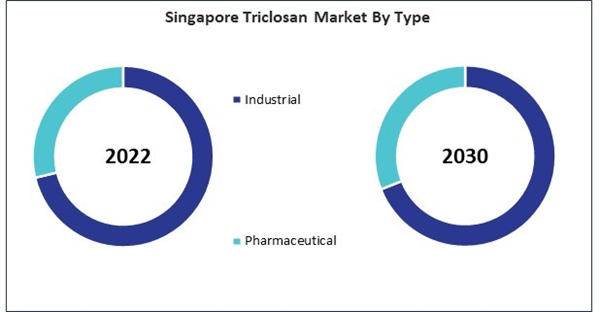Personal care and cosmetics represent a significant segment where this compound finds versatile applications. It is commonly utilized in personal care products such as soaps, body washes, and deodorants due to its antimicrobial properties, which help in eliminating bacteria and providing a sense of cleanliness and freshness. Its inclusion in these products contributes to enhanced hygiene practices and the prevention of body odor. Therefore, the China Market utilized 433.4 Tonnes in Personal care and cosmetics in 2022.
The China market dominated the Asia Pacific Triclosan Market, By Country in 2022, and would continue to be a dominant market till 2030; thereby, achieving a market value of $11.8 Million by 2030. The Japan market is registering a CAGR of 4% during (2023 - 2030). Additionally, The India market would showcase a CAGR of 5.3% during (2023 - 2030).
Triclosan is widely used in personal care products such as antibacterial soap, body washers, hand sanitizers, and deodorants. It functions as an antimicrobial agent, assisting in decreasing or preventing the development of bacteria on the skin, encouraging good hygiene, and avoiding body odour. It is incorporated into cosmetics such as makeup, lotions, creams, and oral care products like toothpaste and mouthwash.
Triclosan is an active ingredient in household cleaning products such as surface cleaners, disinfectants, and laundry detergents. It provides antimicrobial efficacy against a wide range of microorganisms, helping to sanitize surfaces, reduce microbial contamination, and maintain cleanliness in homes, hospitals, and public spaces. This is used in medical and healthcare settings for wound care, surgical scrubs, and antiseptic solutions.
The Asia Pacific region is experiencing rapid economic growth and urbanization, leading to increased healthcare spending and demand for pharmaceutical products. It’s antimicrobial properties make it a valuable ingredient in pharmaceutical formulations, including topical antibiotics, wound care products, and oral antiseptics, driving its adoption in the region’s pharmaceutical sector. Therefore, due to the above-mentioned factors, the market will grow significantly in this region.
Based on Type, the market is segmented into Industrial, and Pharmaceutical. Based on Application, the market is segmented into Personal Care & Cosmetics, Healthcare, and Others. Based on countries, the market is segmented into China, Japan, India, South Korea, Singapore, Malaysia, and Rest of Asia Pacific.
List of Key Companies Profiled
- BASF SE
- Cayman Chemical Company, Inc.
- Merck KGaA
- Spectrum Chemical Mfg. Corp (Spectrum Laboratory Products, Inc.)
- Jiangsu Huanxin High-tech Materials Co., Ltd.
- R A Dyestuffs India Private Limited
- Kumar Organic Products Limited
- Dev Impex
- Salicylates and Chemicals Private Limited
- Shandong Aoyou Biological Technology Co. Ltd
Market Report Segmentation
By Type (Volume, Tonnes, USD Billion, 2019-2030)- Industrial
- Pharmaceutical
- Personal Care & Cosmetics
- Healthcare
- Others
- China
- Japan
- India
- South Korea
- Singapore
- Malaysia
- Rest of Asia Pacific
Table of Contents
Companies Mentioned
- BASF SE
- Cayman Chemical Company, Inc.
- Merck KGaA
- Spectrum Chemical Mfg. Corp (Spectrum Laboratory Products, Inc.)
- Jiangsu Huanxin High-tech Materials Co., Ltd.
- R A Dyestuffs India Private Limited
- Kumar Organic Products Limited
- Dev Impex
- Salicylates and Chemicals Private Limited
- Shandong Aoyou Biological Technology Co. Ltd
Methodology

LOADING...









